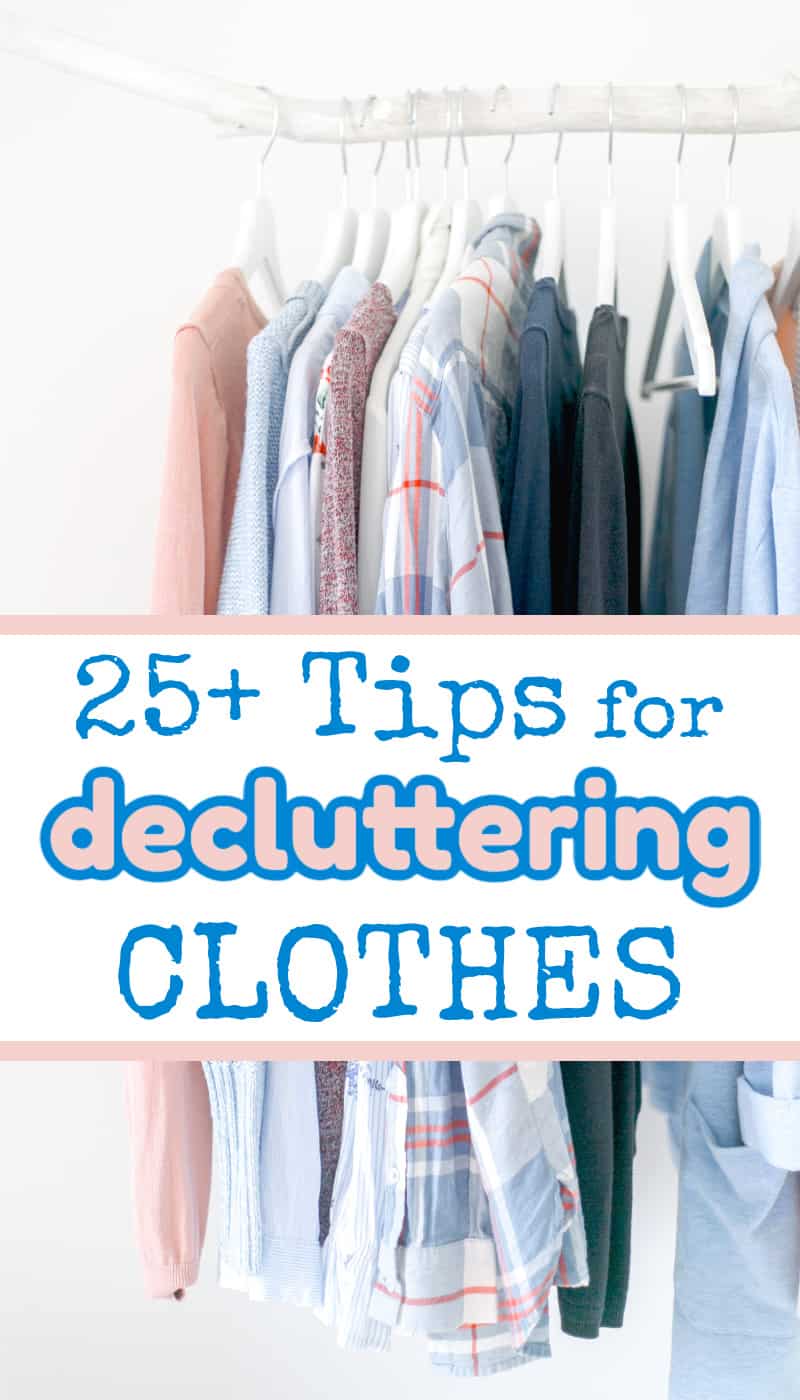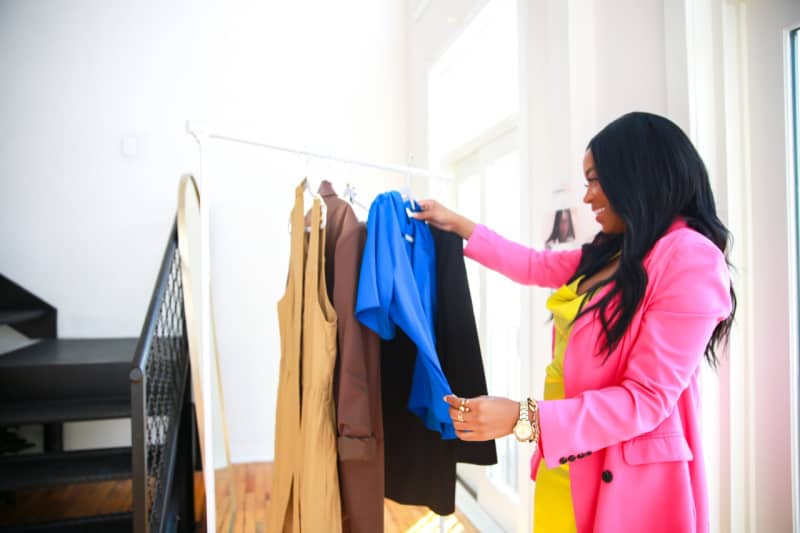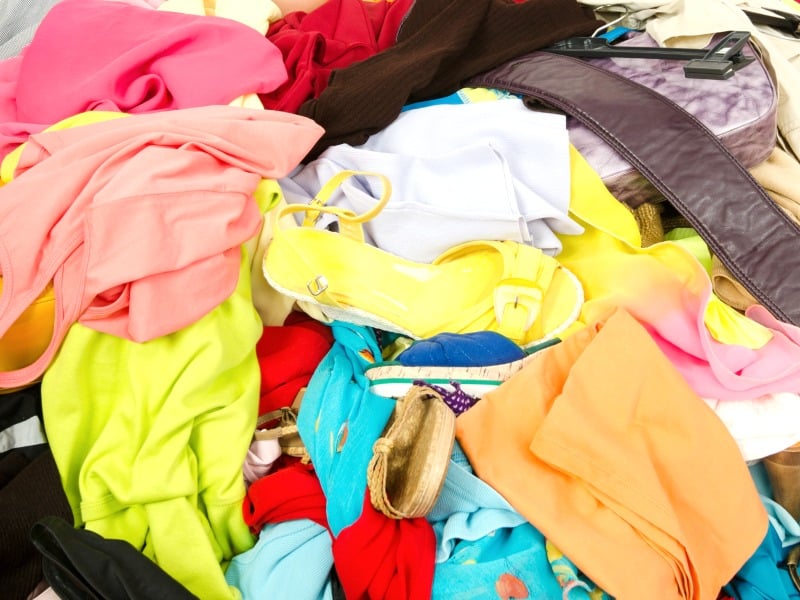Decluttering clothes can be a challenge if you don’t know these more than 60 of the best tips to help you make smart decisions for your wardrobe. This comprehensive guide will help you declutter no matter the number of items you have or the size of your space.

As a professional organizer and mother of three, I know first-hand it can be an overwhelming task to declutter your clothes. When you know these tips and tricks, it makes the decluttering process much easier.
Keep in mind that too many clothes can actually make it difficult to get dressed.
- It’s hard to see and find what you have.
- It’s hard to physically remove items from the closet or dresser drawers.
- You have decision overload when you have too many choices.
- You ended up wearing the same clothing items over and over again.
Experts and medical experts have told us that decluttering can make you happier and healthier. This is just as true for decluttering clothing.
Frequently Asked Questions about Decluttering Clothes
How do you declutter too many clothes?
Start by determining 2 key factors – how many clothes do you need and how much space do you have?
Remind yourself that you deserve:
- Clothes that fit
- Clothes that you love and make you feel great wearing them
- Clothes that fit into your lifestyle
- Clothes that physically fit into your space neatly and comfortably.
- A bedroom that is your retreat of calm and relaxation, with clothes neatly put away.
How can I declutter my clothes fast?
Look for the easy to remove items:
- Stained, torn or damaged
- No longer fit
- Out of style
- You just don’t like
- You don’t have anything to wear with it
- You have too many similar items
Touch each item of clothing only once and make quick decisions.
It’s a good idea to ask a teen or 20-something daughter, family member or a friend to help you decide on clothes to keep. You know who is the best person to help you make good decisions for you and your master closet.

When should you declutter clothes?
Now is the best time to declutter clothes. If you’re thinking about it, then that means you think you need to declutter. Don’t wait.
You can either schedule a 1-3 hour block to go through all your clothes on the weekend or look for a couple of items to declutter every day when you get dressed.
At the end of the day when you get undressed, review each item of clothing and whether you want to keep it or not. How it fit, felt on and made you feel will be fresh in your mind, so it’s a good time to make decisions about what to keep and let go.
Make sure you’re well rested and ready to declutter so you can make the best decisions for your own clothes.
Why is it so hard to declutter clothes?
It’s difficult to declutter clothes for several reasons and for complex combinations of these reasons.
- We need clothes for every day life so we feel guilty letting them go. Unlike decorations or tchotchkes that aren’t needed for practical reasons, clothes are practical and needed. You may be using this as a rationale to keep too many clothing items.
- Clothes represent our wishes and hopes. It can be difficult to change our hopes or even let those go so we can replace them with new ones.
- Clothes are frequently purchased as retail therapy. Looking at those purchases that were made in an effort to make yourself feel better, can bring up either happy feelings or guilt. Both of those feelings can complicate the decluttering process.
How do you be ruthless when decluttering clothes?
- Take time to determine your goals. Write your main goal down and post it so it keeps you motivated.
- Determine how many clothing items you really need. You can use my free 4-page How Many Clothes Do You Really Need checklist.
- Determine how many clothes you have space to hold. Decluttering and organizing is about how much storage space you have first and then how much you can fit into that space.
- Determine what type of clothes you need for your current lifestyle. If your clothing doesn’t fit into your lifestyle, it needs to go.
- Take each item out and quickly make a decision. If you need to try the item on, make a pile for clothes to try on.
- You deserve a wardrobe of clothes that fit you and you love. If the item is stained, torn, out of style, no longer fits or you just don’t like, it needs to go.
- Remember the money is already spent. Keeping the item you don’t want doesn’t bring back the money. It only adds clutter to your life. It’s clutter if you don’t use it or want it.

25 Tips for Decluttering Clothes
1. Set your goals. – Before you dive into decluttering, take a few minutes to determine your goals. This will help you stay focused and make decisions.
2. Determine your limits.
- How much space do you have versus how many clothes you really need?
- What can you easily access and reach?
- If you have limited space, can you store seasonal clothing somewhere else?
3. Determine which decluttering strategy will work best for your personality.
- Would you rather tackle the decluttering process one time for several hours or even a whole day? This allows you to take everything out and start with a clean slate when you put clothing you’re keeping back.
- Would you rather work on one type of item at a time and take several days or even weeks? This allows you to work in smaller blocks of time.
4. Decide when you’ll work on the task. – For example, will you take an entire weekend or will you work on it for 15 minutes or an hour every day?
5. Start with the easy removes. – Before you take a bunch of clothes out and start sorting them, remove unwanted clothes and unworn clothing that you immediately know you don’t want.
6. Sort through your clothing collection by type of clothing. – Take all items in the same category out so you can consider them all at the same time. This gives you a clear idea of how much clothing you have in that category and makes it easy to quickly see if you have an excess of the same item.
7. Try it on in front of a mirror. – Check the item fit, how it looks on you and whether you still like it.

8. Ask yourself these simple questions:
- Does it fit?
- Is it flattering for my body type?
- Is it in style?
- Would I buy it again?
- Does it fit my current lifestyle?
- How many of this specific item do I have and do I need?
- Is it comfortable?
- Do I like it?
- Is it in good condition?
- Does it go with other items I already have?
- Do I have a blouse to go with this skirt or pants?
- Do I have pants or a skirt to go with this blouse or jacket?
- Do I have shoes to go with this outfit?
9. Commit to making good decisions to deal with your excess clothes.
- If it hasn’t fit in the last year, it needs to go.
- If it doesn’t match your currently lifestyle, it needs to go.
- If it’s uncomfortable, it needs to go.
- If you have too many of one type of item and not much space, you need to let some of the extra items go.
- Does it match your personal style? Our taste in clothing changes overtime, so your wardrobe will change, too. If an item no longer fits with your style, let it go.
10. When deciding about which clothes to keep, it’s a good idea to create 3-4 piles or stacks.
- A keep pile
- A throw away pile – for items that are stained or damaged beyond repair.
- A donate pile – must be donated in the next week, otherwise your clutter has moved out of your closet and into a donate pile.
- A sell pile – only put items here if you will take care of listing and selling it in the next two weeks. Whether it’s taking items to a consignment store or selling them yourself, if you can’t commit to that timeframe, donate the items.
11. Only keep it if you have something to wear it with. If keeping particular items will require to purchase new items to be able to wear them, they need to go. You don’t need an excuse to again increase the number of items you have.
12. If you’re having difficulty letting items go, think about the person who will wear the item and be thrilled if you donate it or the person who will be thrilled if you sell it and what you’ll do with the money.
13. All items must be donated or sold in the next two weeks. – No excuses. Don’t let your good work in decluttering become a clutter pile of items to donate or sell.
14. If you feel guilty about how expensive an item was, you need to face reality. The money is already spent. Keeping the item doesn’t bring that money back. Keeping it is now costing you space that could be better used with items you want to wear.
15. There is no reason to keep an item out of guilt. Whether it was a gift or is a sentimental item, like a wedding dress, if you don’t have the space for it, don’t just keep it because you feel guilty. That guilt is taking up space in your closet and in your life and that’s on top of the space the clutter is taking up.
- Take a photo of the item and then let the item go.
- You can appreciate the thoughtfulness of the gift without keeping the item.
- The joy that an item brought you can be multiplied when it is shared with someone else who will enjoy it.
16. Use the 20-20 Rule when thinking about keeping something just in case. – If you’re keeping the item just in case you might need it, ask yourself this important question – Can I replace it for less than $20 and in less than 20 minutes if I find I really do need it in the future? If the answer is yes, then let the item go knowing that you can easily replace it if you find you do need it again.
17. Envision the bedroom, closet and dresser that you want and deserve. – Are the clothes you’re choosing to keep moving your towards your goal?
18. Be realistic in deciding how many special occasion outfits or clothing items you need. – If you only swim once every year or so, you probably only need 1 or 2 bathing suits. If you go to a formal event every year, you probably only need 2-3 formal outfits and 1-2 pairs of formal shoes.
19. Place it in a box for 6 months. – If you think you’re ready to let clothing items go, but you’re just not sure, place them in a labeled box. Set a reminder for 6 months from now. If you never missed the item in those 6 months, then you know you can let it go.
20. Ask a friend or family member to help. – You know the one. Look for a compassionate and honest person to help you with clothes you’re unsure of. Or hire a professional organizer.
21. In dealing with sentimental items that you don’t need or use, keep the good memories and let the item go.
- Take a moment to remember the happy memories, thank the item Marie Kondo style and then let the item go.
- Turn t-shirts of clothes into a quilt or bear.
- Take photos and create a photo book.
22. Use the turn-the-hangers-backward trick. – At the start of every season, turn all the hangers backwards in your closet. When you use an item, turn the hanger back forwards. At the end of the season you’ll clearly see which items you didn’t wear. Those are items you should seriously consider decluttering.
23. Schedule seasonal declutter updates. – Plan for a maintenance decluttering session every 4 months. This will keep you on top of the clutter and prevent clothes clutter from building up again.
24. Decluttering kids clothes – Work through this step-by-step guide with your children as you declutter to teach them the best way to manage their clothing and prevent excess clothing from becoming clutter. This is an important life skill to teach your child.
25. Show yourself grace. – Life happens and clutter does build up. That doesn’t mean that you’ve failed, it just means life happened in the past year(s). Start today with these top tips and make better decisions next time (and next time and next). Decluttering and organizing is a process and a practice, since we are creatures of habit, not a destination.
Tips for Maintaining Your Decluttered Clothes in the Future
When ever you get new clothes, practice the one in one out rule. For each piece of clothing you bring in, you have to get rid of one old piece. This ensures you maintain your current level of clothing and don’t allow excess items in to become clothes clutter.
Keep a donation box or bag in your closet. Toss any items into the box as soon as you realize you no longer want it. When the box is full, take the contents immediately to the charity shop or your favorite local charity.
More Ideas for Organizing Clothes
- Clothes Storage Ideas with No Dresser – More than 70 ideas and products for clothes storage ideas with no dresser. Ideas for every situation and budget.
- How to Fold Clothes – 37 pages of clear and simple steps for folding 22 articles of clothing from a professional organizer. Includes some konmari method of folding and also simple folding ideas.
- Clothes Storage Ideas – Knowing these 5+ tips and options for clothes storage makes all the difference in a small space with limited closet and storage space.
Ready to start decluttering clothes in your closet now? Before you start, be sure to pin for later so you can always find these tips and resources.
Find all our clothes organizing and resources in the table below. You can scroll though the table and look for ideas or search for specific ideas with the magnifying glass in the upper right-hand corner (on desktop). Click on the topic and then click through the specific article.
The post Decluttering Clothes – Everything You Need to Know appeared first on Organized 31.
